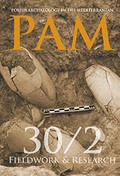Nabataean and Roman coarse ware cooking pottery from Aila (Aqaba, Jordan)
Nabataean and Roman coarse ware cooking pottery from Aila (Aqaba, Jordan)
Author(s): Thomas S. ParkerSubject(s): Archaeology, Cultural history, Visual Arts, Local History / Microhistory, Ancient World
Published by: Wydawnictwa Uniwersytetu Warszawskiego
Keywords: Aqaba; Aila; Nabataean; Roman; Byzantine ceramic cooking vessels; trade;
Summary/Abstract: The Roman Aqaba Project seeks to reconstruct diachronically the economic history of the ancient port of Aila on the Red Sea (now modern Aqaba in southern Jordan). Excavations of Aila between 1994 and 2003 yielded an enormous quantity of stratified ceramic evidence. This paper focuses on coarse ware cooking vessels recovered from Aila dating to the 1st to early 5th centuries. Although the potters of Aila were influenced by the ceramic traditions of the Nabataean capital at Petra, they also developed an independent ceramic tradition. Further, the Roman annexation of Nabataea in 106 CE, including Aila, seems to have had little impact on the local ceramic industry, which continued with little change until the mid-3rd century, which seems to mark an important transition characterized by the disappearance of many long established types and the appearance of new types, including cooking vessels. Although most of these were produced locally, a significant minority was imported to Aila, mostly from the Petra region about 100 km away. This paper presents a typology of these cooking vessels and offers some explanation for the differing quantities of various types of imported cooking vessels over these centuries, with implications for the regional economy in this period.
Journal: Polish Archaeology in the Mediterranean
- Issue Year: 2/2021
- Issue No: XXX
- Page Range: 655-680
- Page Count: 26
- Language: English

